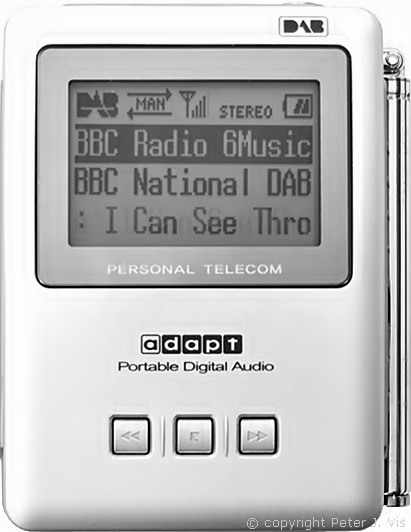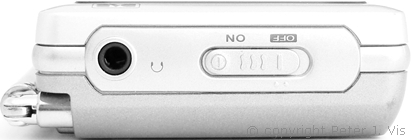Perstel Adapt DR101 Digital Radio

The Adapt DR101, also known as "Perstel DR101" was one of the first pocket digital radios to emerge in the digital radio market. Personal Telecom Inc (Perstel Ltd) manufactured it in Korea, in 2003. It is a DAB digital radio, which is capable of receiving digital audio broadcasts. This means that it receives digital signals created by means of a digital modulation method, which contains audio information. It was one of the earliest DAB pocket radios with dimensions 60 mm × 84 mm × 24 mm in size, and mass 80 g, and a pair of AA alkaline batteries, which lasted around six hours, powered it.
It had a dual tuner system that could receive digital broadcasts and analogue FM, which made it extremely useful as not all FM stations have converted to DAB. Depending upon the country you purchase it, Band-III covers 174 MHz to 240 MHz; Band-L covers 1452 MHz to 1492 MHz, and the FM range was from 87.50 MHz to 108 MHz.
It has a large monochrome LCD display, which is clear with contrast control and backlight. It displays a vast range of information such as remaining battery charge, signal strength, service information, program type, current time, and much more.
DRE200PGE160
This radio uses the TI DRE200PGE160 single chip radio solution made by Texas Instruments. It is a highly optimised digital signal processor (DSP), which consumes very little power, resulting in six hours operation time with just a pair of dry cells. This operation time extends further with the use of modern high capacity rechargeable batteries.
Review
The DR101 enjoyed a long production and many other models replaced it; however, I thought it had some useful features that are still not available on modern DAB receivers.
Launched in January 2003, it was the world’s smallest digital radio that could also receive traditional FM broadcasts as well. However, the good news is that the successor models to this such as DR601 are even better and worth looking at.
You never know how good a piece of technology really is until it is discontinued, and other models are made. Having seen and tried almost every model on the market, this one is my favourite. This has now become a classic vintage design that many people would love to acquire.
Power Switch

The DR101 has a mechanical power switch, which is an excellent design feature; because you could leave a pair of dry cells in the radio, and come back to it after a week without finding the cells depleted.
The fact it uses standard dry cells means that you could use some of the latest high capacity rechargeable batteries, which are very cheap today.
After having looked all the latest radios, the DR101 seems much better, because in terms of usability, quality, and reliability, it is excellent.
Sound Quality

The audio power output is 5 mW into a 16 Ω headphone coil. The sound quality is excellent however, the only thing letting it down were the cheap headphones that came with it, which provided an average sound. The supplied headphones were quite lousy in design and the only one feature I did not like about this radio. They were hard pieces of plastic, which would not fit into my ears, and were painful to wear. However, if you ditch those and use something like my vintage Sony MDR-W15 Dynamic Headphones, the sound quality will improve drastically. I had this radio connected to my amplifier and the sound was excellent and well above average.
Reception Quality

I live in London in a strong signal area and the reception is excellent; I have never had any problems with signal detection in buses or trains.
This radio uses an assembly grouping system called "ensemble tuning", which is simplistic and has much merit as it detects a broadcast stream and then provides you with an option to choose the stations available within it. I thought this was much more logical, as I have had radios that lock up if the station was not available. Usually, one appreciates this kind of feature after trying out other radios.
Another interesting feature about this radio is that the digital radio tuner circuit is housed inside a metal container, which shields it from stray electromagnetic interference. An advantage of this is that it shields the circuitry from noise generated by mobile phones, and other digital equipment. This design aspect makes this portable unit perform better than other models I have used. You can see the design of the tuner in the following sections of this article.
eBay / Amazon
The digital pocket radio market is still very active, and the DR101 is useful and still desirable. It did not see huge production runs however there are still many around in good condition because they were not cheap when first introduced. The second-hand value is around £25.00 for a working unit in a reasonable condition. However, a new unit still in its box may be worth much more.
This Article Continues...

Perstel Adapt DR101 Digital Radio
Perstel DR101 Pocket Digital Radio PCB
DRE200PGE160 Single Chip Radio
Digital Baseband System
Perstel DR101 Digital Radio Tuner
Perstel DR101 Specification
Perstel DR101 Case
DAB and DAB+
The Best Digital Radios
Perstel DR101 Battery and Adapter